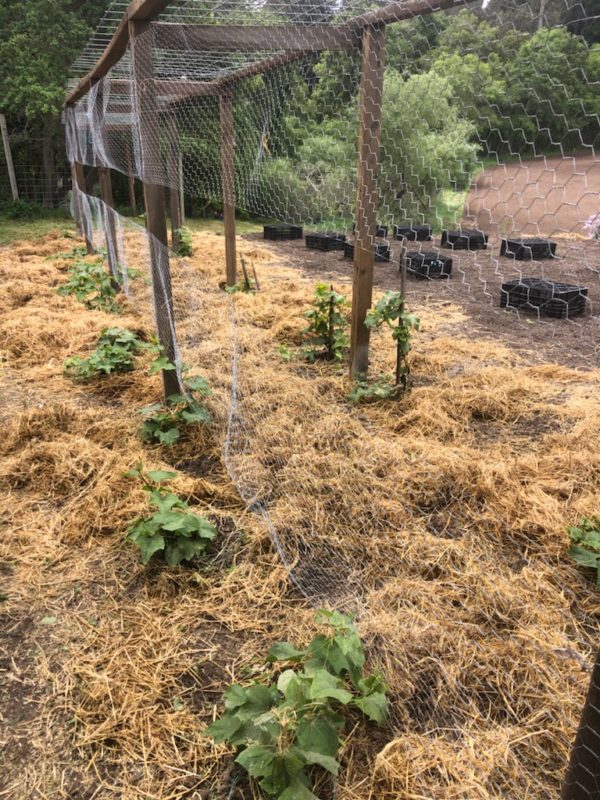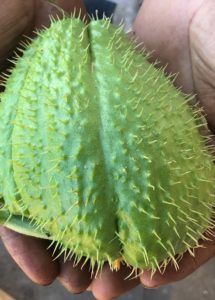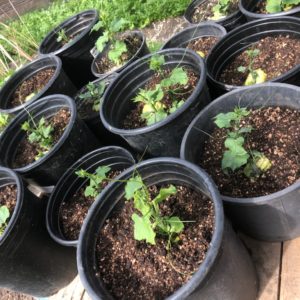From Oaxaca to Watsonville

Fidel is working out a grass roots level marketing program for his nascent farm. He shows up on Sunday mornings at the laundromat where the Oaxacan women congregate with his car loaded full of fresh produce. Watsonville is no food desert. Our town is surrounded by farms, many people who live in town work on farms, and if you stroll around the suburbs you’ll see plenty of gardens. If there’s a big patch of fava beans in someone’s yard you can almost bet that a family of Azorean Portuguese descent lives there. The huge, floppy leaves of a Taro plant suggests that the residents have roots in the Philippines or Pacific Islands. And there are plenty of markets scattered about that cater to every taste, from mainstream supermarkets like Safeway to more specialized ethnic markets that cater to Mexicans or Japanese. Fidel has worked for us for at least ten years but he wants to have his own farm so it’s natural that he’s reaching out to his own community of immigrant Oaxacans for support. I’m trying to help him get started by sharing some of our greenhouse space with him, and he’s teaching me how to grow some of the varieties of vegetables and herbs that are grown and appreciated in Oaxaca. Right now I’m learning about chayote.
If you want to be a farmer it can’t hurt to take classes in plant biology, crop and soil science, or business. But you can also get into farming the way I did and learn by just doing the work. If we’re smart we learn from our mistakes and do better every time we try, and getting better at farming is no exception. But if we’re really wise we can learn from other people’s mistakes and spare ourselves some agony. I’m impressed with Fidel because he has an industrious and curious nature about him. He has a lot of questions and I’m happy to try and answer them as best I can. I remember how important it was for me to have spent a number of years working at Star Route Farm in Bolinas during the early 1980s when my employer, Warren Weber, was so generous with his time and knowledge. He taught me how to farm and I figure now is my time to pay him back in spirit by helping someone else. Besides, Fidel seems to be a natural, not just at growing food but selling it too.

Many people have come from Oaxaca to Watsonville to work in the strawberry fields. Sure, Oaxaca is part of Mexico and the Hispanic markets are here to serve their community. But Oaxaca is also a nation unto itself, or rather a region with a number of very independent nations with a number of different indigenous languages and ancient traditions and the people resist being reduced to a generic “Mexican” status. They have their own ways of preparing food and they have their own varieties of herbs and vegetables that they can’t always find in the markets here. Fidel saw an opportunity to grow some of these ethnic crops, like alache, which is a herb in the okra family with leaves that are used to thicken soups and stews, the way filet is used to give body to gumbo. When he shows up at the laundromat the Oaxacan women will leave their laundry swishing in the washing machines and come out into the parking lot to inspect the fresh alache, turning the bunches over and buying what they need. They’ll be cooking later on that day and they’ll tell their friends about where they were able to find these greens they all miss. This parking lot “pop-up” strategy is perfect marketing- convenient, convivial, and “viral,” if I may use that word in these times. But Fidel grows other unusual crops too, and I’m most interested in the chayote.
Chayote, or Sechium edule, is not an uncommon crop in Mexico. In fact, chayote isn’t even an uncommon crop across the world, despite the fact that it is still relatively unknown across white bread America. The chayote plant is native to Southern Mexico and Central America, but when Columbus came to the “New” world sparking the so-called “Columbian Exchange” this squash family member was dispersed across South America and also found new homes in Asia and eventually even in Australia. Most chayote varieties are smooth skinned, with a firm but creamy flesh that can be used like their summer squashes cousins are, but can also be grated, tossed with lime juice and served as salad. But the Oaxacans prefer a very spiny variety of chayote- not as convenient for a cook to prepare perhaps, but more to their taste, more “authentic.” So Fidel is growing the spiny Oaxacan variety. As for me, I’m always interested in any crop that can find a happy home across cultures. I think of myself as “ethnic Californian,” which means that, like my state, I’m open for business across the myriad of cultures that make up our population. Plus I’m curious about food. I haven’t cooked chayote and I’m looking forward to learning how. Besides the squashy fruits, the plant also has big, potato-like tubers that can be cooked like potatoes and I’m looking forward to trying them.
Fidel described for me how to build a frame for the chayote plants to climb on. He gave me a number of different chayote plants of different varieties; smooth skinned, spiny, white-fruited, yellow fruited, green fruited. He told me how to protect the tubers from the gophers by putting them in wire baskets so that the plants could sprout back from underground every year as soon as the soil warmed up. And Fidel encouraged me to top off the frame with a rigid and strong mesh so that the squash can hang down to be picked easily by reaching up into the foliage with a pair of clippers. So far, so good. As the weather has warmed the young chayote plants are picking up speed, and this weekend, as cold as it was, the first vines still managed to grab onto the wire mesh and start their ascent. In the fields our summer squash are just flowering, but our chayotes won’t be ready until early fall. That should work out perfectly. I planted 20 plus chayote seedlings, and this planting will likely provide us with many, many pounds of harvest. At the very least we’ll be able to select out the varieties that perform the best here in Watsonville.
a number of different chayote plants of different varieties; smooth skinned, spiny, white-fruited, yellow fruited, green fruited. He told me how to protect the tubers from the gophers by putting them in wire baskets so that the plants could sprout back from underground every year as soon as the soil warmed up. And Fidel encouraged me to top off the frame with a rigid and strong mesh so that the squash can hang down to be picked easily by reaching up into the foliage with a pair of clippers. So far, so good. As the weather has warmed the young chayote plants are picking up speed, and this weekend, as cold as it was, the first vines still managed to grab onto the wire mesh and start their ascent. In the fields our summer squash are just flowering, but our chayotes won’t be ready until early fall. That should work out perfectly. I planted 20 plus chayote seedlings, and this planting will likely provide us with many, many pounds of harvest. At the very least we’ll be able to select out the varieties that perform the best here in Watsonville.
 a number of different chayote plants of different varieties; smooth skinned, spiny, white-fruited, yellow fruited, green fruited. He told me how to protect the tubers from the gophers by putting them in wire baskets so that the plants could sprout back from underground every year as soon as the soil warmed up. And Fidel encouraged me to top off the frame with a rigid and strong mesh so that the squash can hang down to be picked easily by reaching up into the foliage with a pair of clippers. So far, so good. As the weather has warmed the young chayote plants are picking up speed, and this weekend, as cold as it was, the first vines still managed to grab onto the wire mesh and start their ascent. In the fields our summer squash are just flowering, but our chayotes won’t be ready until early fall. That should work out perfectly. I planted 20 plus chayote seedlings, and this planting will likely provide us with many, many pounds of harvest. At the very least we’ll be able to select out the varieties that perform the best here in Watsonville.
a number of different chayote plants of different varieties; smooth skinned, spiny, white-fruited, yellow fruited, green fruited. He told me how to protect the tubers from the gophers by putting them in wire baskets so that the plants could sprout back from underground every year as soon as the soil warmed up. And Fidel encouraged me to top off the frame with a rigid and strong mesh so that the squash can hang down to be picked easily by reaching up into the foliage with a pair of clippers. So far, so good. As the weather has warmed the young chayote plants are picking up speed, and this weekend, as cold as it was, the first vines still managed to grab onto the wire mesh and start their ascent. In the fields our summer squash are just flowering, but our chayotes won’t be ready until early fall. That should work out perfectly. I planted 20 plus chayote seedlings, and this planting will likely provide us with many, many pounds of harvest. At the very least we’ll be able to select out the varieties that perform the best here in Watsonville.—© 2021 Essay and Photos by Andy Griffin.
Top photo is the Growing Chayote Vines.
If you haven’t ordered a mystery box recently, now is a great time to get in on spring deliciousness! LadybugBuyingClub


